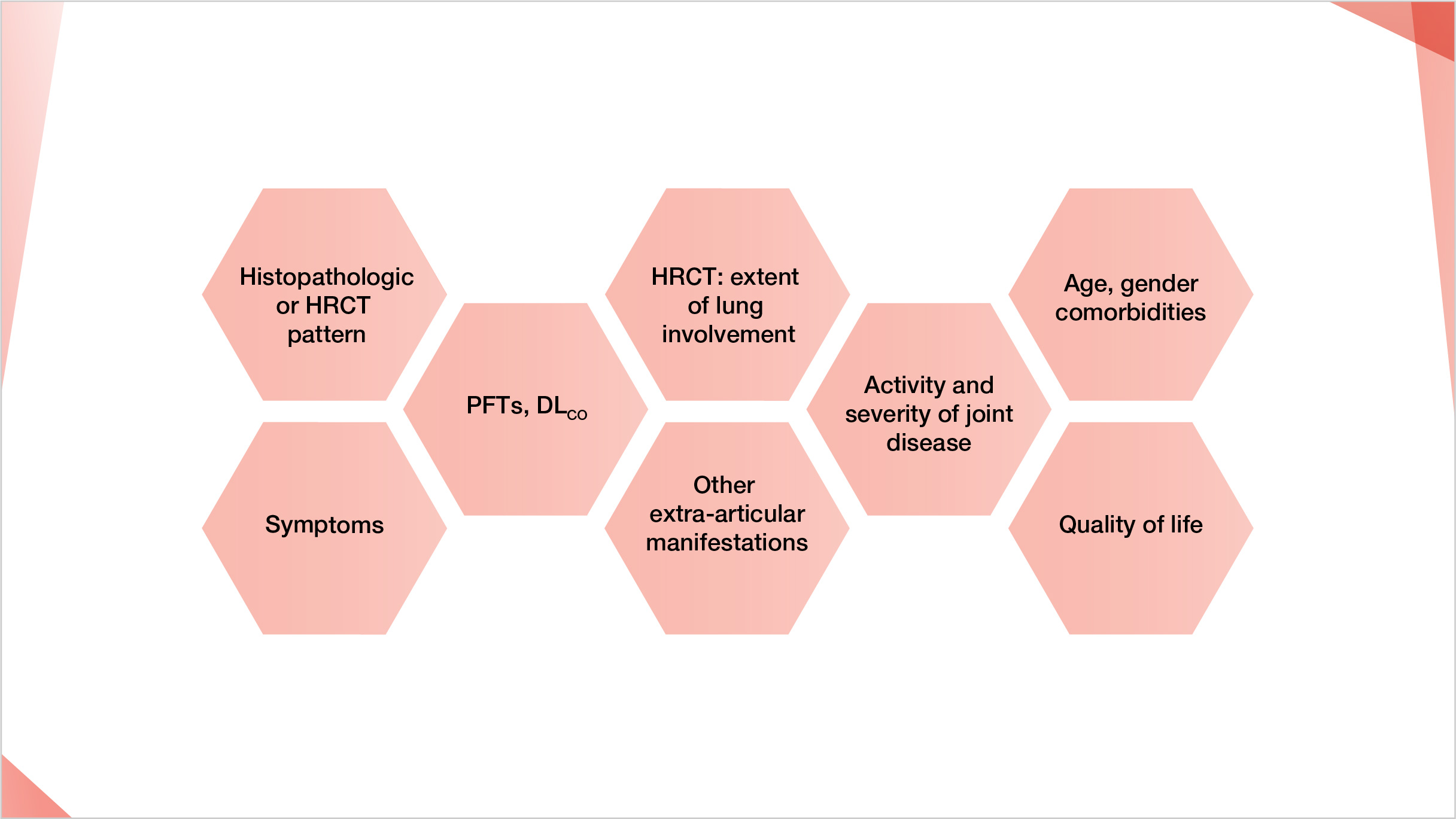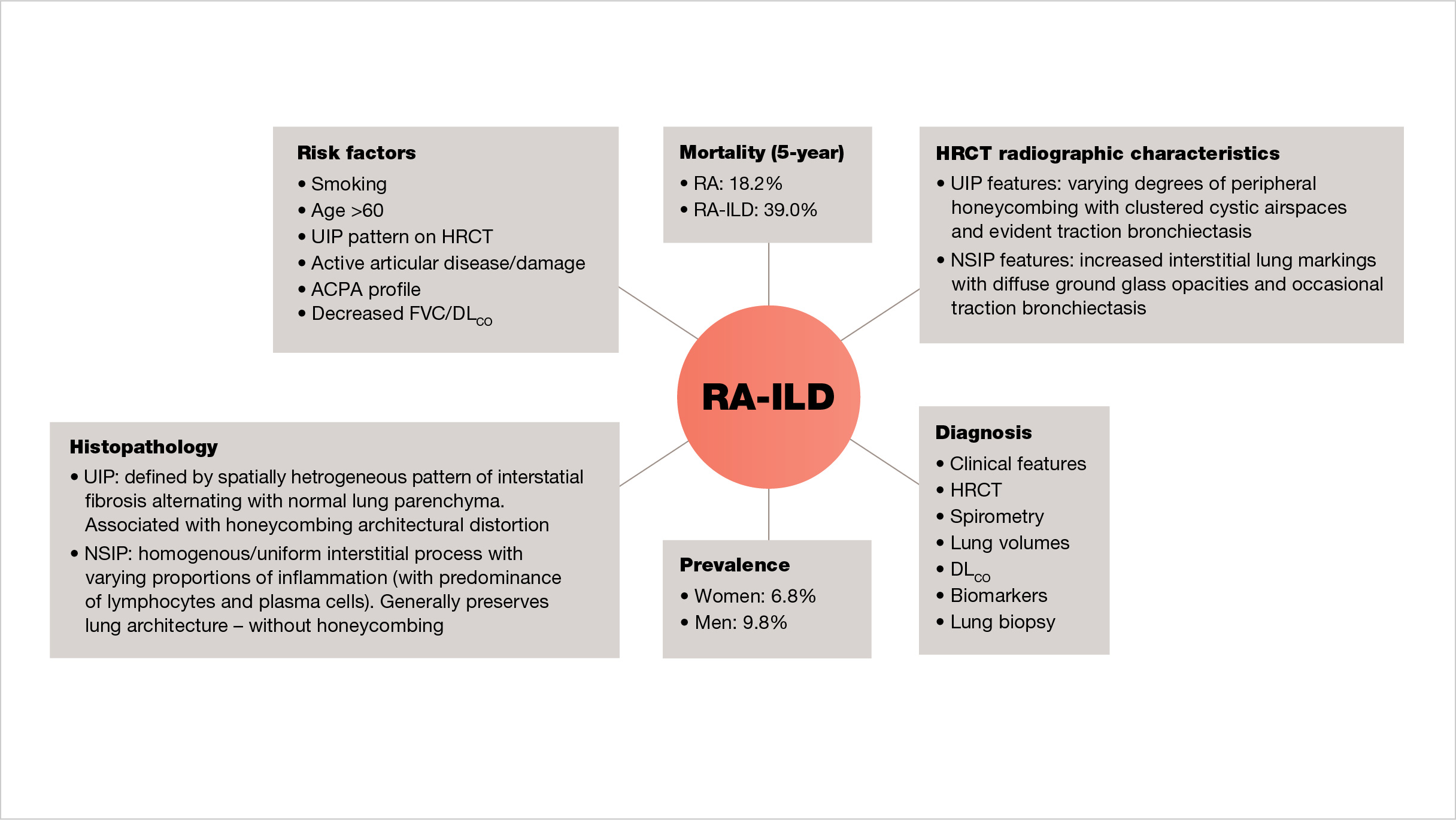Diagnosis of RA-ILD
High-resolution computed tomography (HRCT) is considered the gold standard for diagnosis of interstitial lung disease (ILD) in rheumatoid arthritis (RA)1–3

HRCT COMBINED WITH MULTIDISCIPLINARY EVALUATION PROVIDES HIGH CONFIDENCE IN DIAGNOSIS OF ILD IN PATIENTS WITH RA1–3
Chest HRCT is the most sensitive and specific method for diagnosing ILD in RA, and allows for ILD extent and radiological pattern to be assessed.4 A multidisciplinary approach, including at least a rheumatologist, pulmonologist and radiologist, enhances diagnosis and management of RA-ILD.1,5
Find out more about how to diagnose RA-ILD using HRCT
In addition to HRCT, diagnosis of RA-ILD is primarily based on clinical presentation, physical examination and PFTs.2
Proposed framework for the multidisciplinary evaluation of RA-ILD1

Overview of RA-ILD including HRCT diagnosis6

Reprinted by permission from: Springer Nature, Current Rheumatology Reports, Rheumatoid Arthritis-Associated Interstitial Lung Disease: Current Concepts, Brito et al, ©2022.
Once you have reached a diagnosis, how should you manage your patients with RA-ILD?

Monitoring and management of ILD progression in RA-ILD

Multidisciplinary teams

Providing palliative/supportive care
Footnotes
-
ACPA, anti–citrullinated protein antibody; CTD-ILD, connective tissue disease-associated interstitial lung disease; DLCO, diffusing capacity of the lung for carbon monoxide; FVC, forced vital capacity; HRCT, high-resolution computed tomography; ILD, interstitial lung disease; NSIP, non-specific interstitial pneumonia; PFT, pulmonary function test; RA; rheumatoid arthritis; RA-ILD, rheumatoid arthritis-associated interstitial lung disease; UIP, usual interstitial pneumonia.
-
-
Cassone G, Manfredi A, Vacchi C, et al. Treatment of rheumatoid arthritis-associated interstitial lung disease: lights and shadows. J Clin Med. 2020;9(4):1082. doi: 10.3390/jcm9041082.
-
Iqbal K and Kelly C. Treatment of rheumatoid arthritis-associated interstitial lung disease: a perspective review. Ther Adv Musculoskelet Dis. 2015;7(6):247–267.
-
Kawano-Dourado L, Doyle TJ, Bonfiglioli K, et al. Baseline characteristics and progression of a spectrum of interstitial lung abnormalities and disease in rheumatoid arthritis. Chest. 2020:S0012-3692(20)31412-4. doi: 10.1016/j.chest.2020.04.061.
-
Fong WWS and Yoong JKC. Interstitial lung disease and rheumatoid arthritis: a review. Proc Singapore Healthc. 2015;24(1):35–41.
-
Castelino FV, Goldberg H, Dellaripa PF. The impact of rheumatological evaluation in the management of patients with interstitial lung disease. Rheumatology (Oxford). 2011;50:489–493.
-
Brito Y, Glassberg MK, Ascherman DP. Rheumatoid Arthritis-Associated Interstitial Lung Disease: Current Concepts. Curr Rheumatol Rep. 2017;19:79. doi: 10.1007/s11926-017-0701-5.
-
Wijsenbeek M, Cottin V. Spectrum of Fibrotic Lung Diseases. N Engl J Med. 2020;383:958–968.
-
Ryerson CJ, Cayou C, Topp F, et al. Pulmonary rehabilitation improves long-term outcomes in interstitial lung disease: a prospective cohort study. Respir Med. 2014;108(1):203-210.
-
Kreuter M, Bendstrup E, Russell A, et al. Palliative care in interstitial lung disease: living well. Lancet Respir Med. 2017;5(12):968-980.
-
Maher TM, Wuyts W. Management of Fibrosing Interstitial Lung Diseases. Adv Ther. 2019;doi:10.1007/s12325-019-00992-9. [Epub ahead of print].
-
Sgalla G, Cerri S, Ferrari R, et al. Mindfulness-based stress reduction in patients with interstitial lung diseases: a pilot, single-centre observational study on safety and efficacy. BMJ Open Respir Res. 2015;2(1):e000065.
Resources for patients




